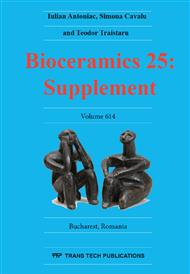p.74
p.83
p.89
p.95
p.100
p.105
p.113
p.118
p.124
Effect on Adhesion to Tooth Structure for some Experimental Dental Adhesive System
Abstract:
The present study was conducted with the aim of evaluating and comparing the microleakage at the dentin and enamel/composite interfaces of two adhesive systems. The adhesives are: a new-developed experimental adhesive systems and OptiBond FL (Kerr Corp.) The new adhesive system was prepared for the composite material as three steps adhesive (etchant, primer and bonding). The bonding resin contains the base monomer that was present in the corresponding composite material, HEMA and TEGDMA as diluents. Twenty box-type Class V standardized cavities were prepared on the facial and oral surfaces of each tooth, with coronal margins in enamel and apical margins in cementum (dentin). The preparations were restored with two restorative materials a new experimental microfilled resin composites based on Bis-GMA analogue and hybrid resin composite Herculite XRV Ultra (Kerr Corp.). The teeth were thermocycled and immersed in 2% methyl blue solution for 24 hours. The specimens were sectioned buccolingually into 3 slices and the resulted sections were examined using a stereomicroscope under 40x magnification. The extent of dye penetration was measured in a quantitative manner. This measurement was converted into percentage using the formula described by Sano et al. I=p/Lx100. These percentage values were submitted to variance analyses (ANOVA) and t test at a p<0.05 level of significance. Scanning electron microscopy was used in order to see the interface between tooth and composite restoration. Significantly less microleakage was associated with the use of OptiBond FL adhesive system at the enamel surface. Between the enamel and the dentin margins no significantly statistical differences were found just for the experimental adhesive system. This adhesive containing water and ethanol as solvent performed significantly better at the dentin margins.
Info:
Periodical:
Pages:
100-104
Citation:
Online since:
June 2014
Price:
Сopyright:
© 2014 Trans Tech Publications Ltd. All Rights Reserved
Share:
Citation:


